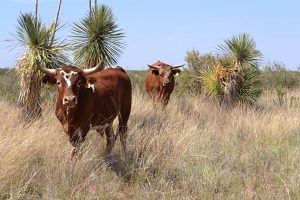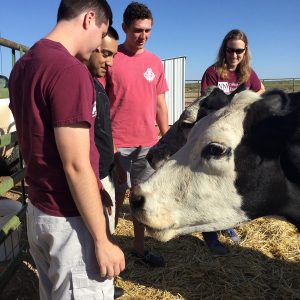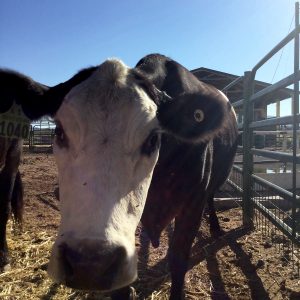By: Kristie Garcia
 |
|
| New Mexico State University electrical engineering students are designing a camera prototype to help researchers at the Jornada Experimental Range learn more about Raramuri Criollo cattle. The camera will be attached to a harness around the neck of the cow. (Photo by Andrea Campanella) AUG16 |
The students are part of the two-semester-long senior capstone design class advised by Laura Boucheron, assistant professor in the Klipsch School of Electrical and Computer Engineering. They’re all seniors and expect to conclude their design project in December.
“We want our students to take the concepts they have from all of the courses that we’ve taught them and synthesize them together and design something,” Boucheron said. “The idea is that they’re taking concepts from a variety of different subdisciplines in their engineering, putting them together, learning how to present to a variety of audiences and actually building something that they can test and demonstrate."
Rick Estell, research animal scientist with the Jornada Basin Long Term Ecological Research program, is part of a team studying Raramuri Criollo cattle.
“Raramuri Criollo is a biotype that’s pretty rare,” Estell said. “It originated in Northern Africa and came over with the Spaniards in the 1500s into Central America. They went through this process of natural selection for 500 years or so before gradually disappearing except in isolated areas.”
About 10 years ago, Estell’s colleague brought 27 Criollo cows to the Jornada Range from Mexico. Now, the population on the range is about 200.
 |
|
| New Mexico State University electrical engineering students (from left to right) Zach Abbott, German Montes and Christian De La Pena stand with Laura Boucheron, assistant professor in the NMSU Klipsch School of Electrical and Computer Engineering, as they get acquainted with cows at the Jornada Experimental Range. The students are designing a camera prototype to help researchers learn more about cattle. (NMSU photo by Kristie Garcia) AUG16 |
“What we’re doing is comparing these animals to the standard black baldies that most producers in this area use,” Estell said. “There’s hardly any information on Criollo, so we want to know what they’re eating and how they distribute themselves on the landscape.”
The engineering students and Boucheron went to the Jornada Range earlier this month to take some measurements. Several factors must be taken into consideration, such as the circumference of the cow’s neck and the distance from the camera location to the vegetation on the ground.
The electronics of the camera are complete at this point, and the next step is packaging the camera. The students will need to come up with a design that can withstand weather and force. Regarding placement, they need to consider any obstructions that may arise.
“At this point in the project, the biggest challenge is going to be designing an enclosure for the device,” Abbott said. “It will need to contain all the systems and meet our durability requirements.”
If the prototype works, Estell hopes that eventually cameras on multiple cows will help him and other researchers gather useful information.
“The idea is that these are hardy animals that are very adapted to harsh environments,” he said. “And some of the larger cattle we use nowadays can be a little bit harder on the landscape than what we want them to be. So we’re looking for something that’s a little bit more matched to this fragile ecosystem.”
At this early stage, researchers do not know whether there are significant advantages of Criollo cattle.
 |
|
| An Aberdeen Angus Hereford cross cow looks into the camera at the Jornada Experimental Range. New Mexico State University electrical engineering students made a trip to the range to take the cow’s measurements. The students are designing a camera prototype to help researchers learn more about Raramuri Criollo cattle. The camera will be attached to a harness around the neck of the cow. (NMSU photo by Kristie Garcia) AUG16 |
“It’s all hypothetical right now,” Estell said. “But if it turns out that they’re a better fit, producers and ranchers might have another option. There are some drawbacks to these smaller animals, so marketing is another part of this whole thing that we’d have to work out before it’s a viable option. But that’s what we hope – that it might give producers some more flexibility.”
Operated by the Department of Agriculture’s Agricultural Research Service, data have been collected on the Jornada Experimental Range since 1915. Data have been collected for the LTER project, administered by NMSU, since 1983.
